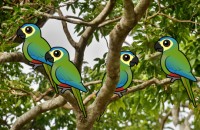Birdorable #99: The Common Kestrel
The Common Kestrel is native to parts of Europe, Asia and Africa. They hunt by hovering 10 to 20 meters over the ground in search of prey. These small birds of prey are often seen hovering by highways, looking for mice, voles and other small rodents. This is our totally cute version of the Common Kestrel and our 99th Birdorable species:






Comments
Be the first to comment
Thank you!